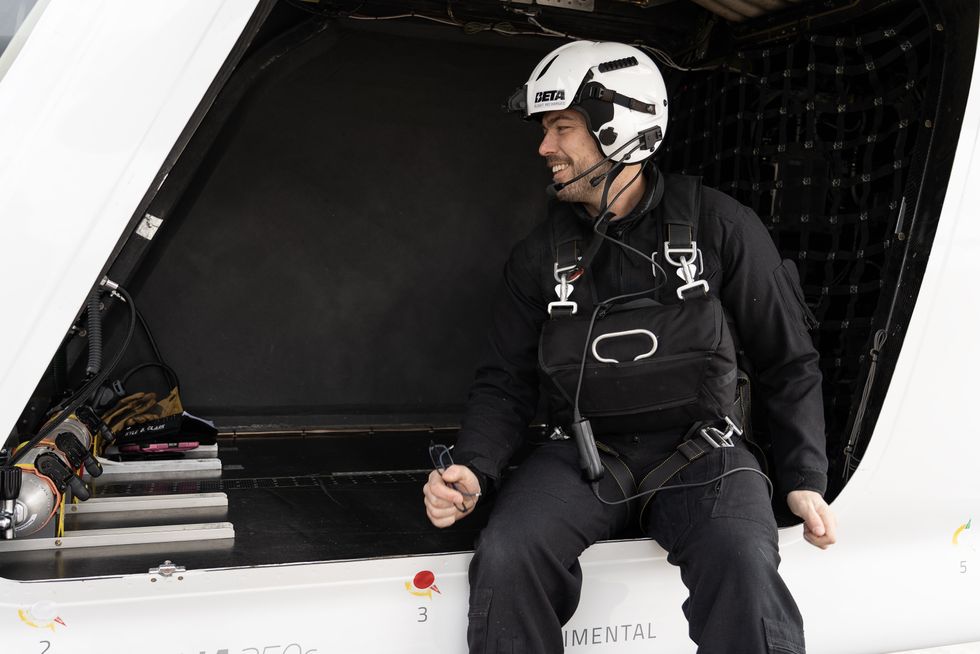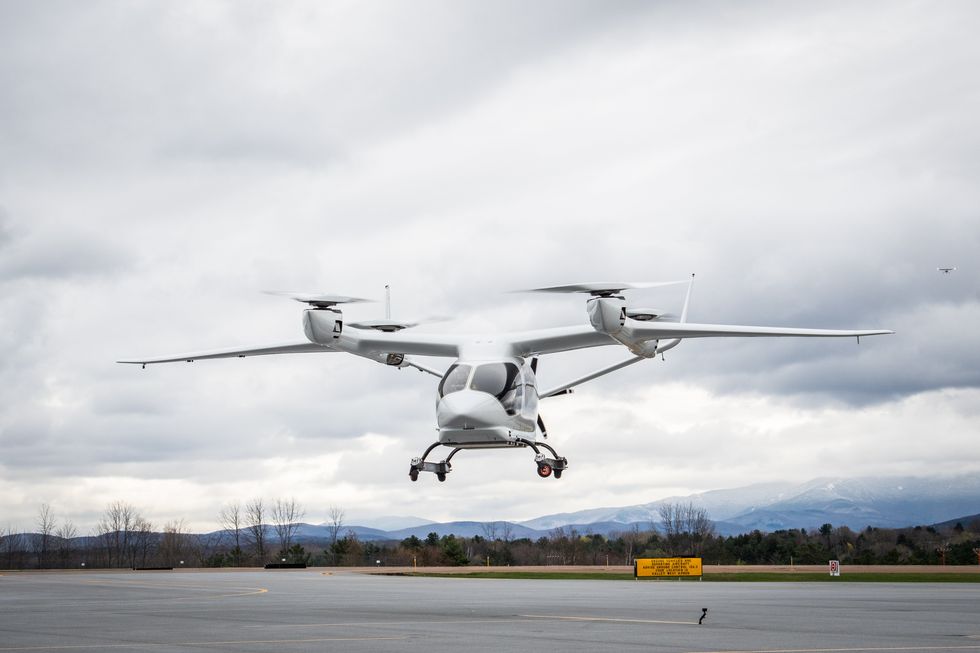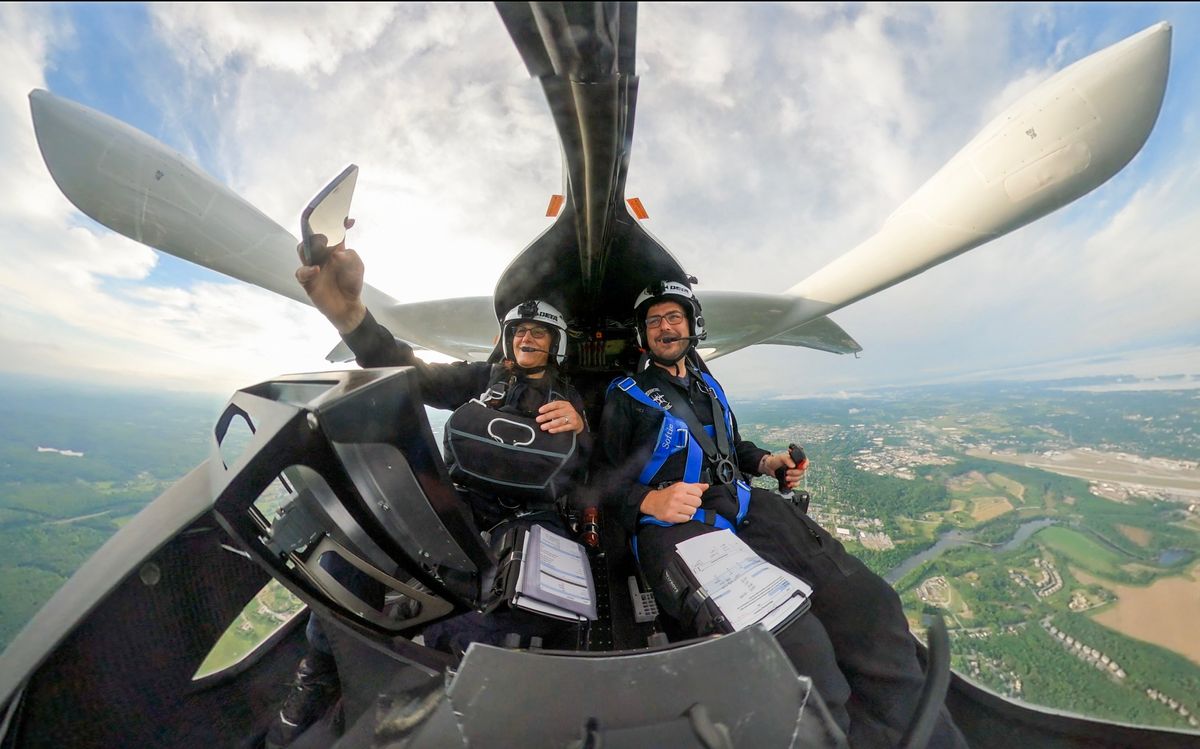Kyle Clark, the 43-year-old founder and CEO of Beta Technologies, is not quite your typical tech entrepreneur. For one thing, he’s a former professional ice hockey player. Then, too, many afternoons you won’t find him behind a desk at the company’s headquarters near the airport in Burlington, Vt. In fact, you won’t find him on the premises at all because he’s up in the air, flying one of the company’s radically innovative electric aircraft.
Kyle Clark
Employer:
Beta Technologies
Title:
CEO
Education:
Bachelor’s degree in materials science engineering, Harvard
Among the hundreds of companies building electric vertical takeoff and landing aircraft, Beta has established itself as the clear No. 2, behind Joby Aviation. On 2 October, Beta announced the completion of a 17,500 square-meter manufacturing facility, in South Burlington that will eventually be capable of producing 300 aircraft per year. No other eVTOL company has comparable manufacturing capabilities except for EHang, in China, although Archer Aviation, Joby, Lillium, Overair, and Volocopter are now operating or building production facilties.
It’s another memorable milestone for Clark, “the most impressive polymath I’ve ever met,” says Dean Kamen, an IEEE Honorary Member and president of Deka Research & Development Corp. “He has the most broad-based collection of skill sets and experience in physics, aerodynamics, structures, propulsion, and electric motors. He’s remarkable.”
Growing up in Essex, Vt., Clark dreamed of flying, and building, aircraft. But as a nearly 200-centimeter (6-foot-6-inch) teenager, he also played ice hockey in high school with a fierceness and physical style that landed him a spot on the U.S. National Junior Team, a group of young elite players being developed for possible inclusion on the U.S. Olympic team. There he became a legend for his energy and commitment: He racked up 171 penalty minutes in one season, which still stands as the U.S. National Junior Team record. (He was also named team captain.)
From Harvard to the NHL

Next stop: Harvard, in 1998, to pursue a bachelor’s degree in engineering. He played on the university’s hockey team, and also dreamed of building a radically different kind of aircraft. During his freshman year, he became consumed by an idea he had for “a hybrid-electric aircraft that utilized a very high-power-density motorcycle engine to drive a pusher propeller in an aircraft with a high wing and a fly-by-wire system.” It was the basis of the two aircraft now being built at Beta Technologies. But getting those aircraft built would be a roundabout journey, starting with a detour into professional ice hockey. During his junior year, he left Harvard after he was drafted by the National Hockey League’s Washington Capitals.
“I went and played hockey for a while, but that’s kind of where the Beta story starts,” he explains. “I was always enamored with airplanes. I got my signing bonus from the Capitals, and I literally went straight to the airport and said, “I want to get a pilot’s license.” And he did.
After knocking around the Capitals’ farm system for a couple of years, Clark returned to Harvard to finish his degree in materials science engineering. After his junior year, he met Valery Kagan, an elderly Russian-born engineer who taught Clark “some basic principles of power electronics design.” Around the same time, through a company where he interned, Husky Injection Molding in Milton, Vt., he became aware of “a problem in thixotropic magnesium molding,” a technique used to produce strong and lightweight parts out of magnesium.
A problem leads to a startup
In 2005, Clark, Kagan, and three others launched iTherm Technologies in South Burlington. “It was my job to work like hell to solve the problem,” Clark recalls. That problem was lack of power supplies robust enough to withstand the demands of high-impedance induction heating, on which the magnesium molding technique depended.
“I built hundreds of power supplies and blew up hundreds of IGBTs [insulated gate bipolar transistors], just sitting there with an oscilloscope and LabView for controls,” he adds. This is how Clark got his first intense experiences in real-world electrical engineering, which would serve him well later on at Beta.
For his bachelor’s degree thesis, Clark designed a flight-control system for that hybrid-electric aircraft of his dreams. It was named student paper of the year by Harvard’s engineering department.
“You can’t be a good electrical engineer unless you have generated enough empathy for the people that are going to use the product.”
iTherm, meanwhile, became a profitable company and was sold to Dynapower, an energy-storage and power-conversion firm in South Burlington. With the proceeds from the sale, and following a few additional ventures, Clark got the chance to focus on aviation full time with the launch of Beta.
His big break came five years later during a chance meeting with the investor and entrepreneur Martine Rothblatt, who had made a fortune from starting up Sirius Satellite Radio. In 1996, Rothblatt founded United Therapeutics, a biotech company based in Silver City, Md., that she established with a long-term goal of greatly expanding rapid access to organs for transplantation. A centerpiece of her vision was building an electric rotorcraft that could swiftly ferry the organs to hospitals.
With US $48 million from Rothblatt, in 2017 Clark and a team of eight got to work. About $1.5 million of that went to building the first, prototype, aircraft. “In 10 months, we built a 4,000-pound [1,800-kilogram] electric vertical takeoff and landing prototype,” Clark says.
The technology used in electric aircraft
It was an auspicious start. Today, Beta has some 600 employees and a market valuation of $2.4 billion, according to Prequin. It is building two electric aircraft based on the same basic airframe, each with a 15-meter wingspan. Both are designed to carry a pilot and either four passengers or three standard cargo pallets. The only major difference between the two is related to horizontal rotors: one has them, and the other doesn’t.
The Alia-CX300 is an eCTOL (electric conventional takeoff and landing) aircraft with a single pusher-prop in back for propulsion. The Alia-250 adds four rotors on top for vertical lift, so it is an eVTOL. So far, Beta has built a prototype of each, both of which are flown nearly every day, Clark says.

The company has sales contracts or agreements for its aircraft with Air New Zealand, Bristow Group, LCI Aviation, United Therapeutics, UPS,the U.S. Air Force, and the U.S. Army. Beta is also working on a network of charging stations in the United States capable of charging not only its aircraft but also conventional road EVs. It has built about a dozen such stations and has around 55 more in development.
Advice for young engineers
Clark, an IEEE member, advises young engineers interested in working on eVTOLs to do “real” engineering. “We see people who are very good on analytical tools, but they haven’t developed the intuition to understand where they’re going to take haircuts because of design for manufacturing, or material availability, or what can actually be made without a massive tooling cost. All these things require an intuition that’s only developed by building things. By micro experimentation.
“Sitting down and actually doing the hard work of writing code makes you appreciate how hard it is to actually just fix things in software when the software is safety critical,” he adds. “Molding things out of composite makes you realize that ‘I can’t put that radius in there to make that thermal shroud for the power electronics.’ Building things with semiconductors, you realize, ‘Hey, that may have a datasheet, with a heat-transfer coefficient between the junction and the heat sink, but I’m never actually getting that kind of transfer because thermal paste dries out.’ You start to develop your own intuitive book of knowledge of where the real gremlins hide in engineering.”
He stresses that success in engineering means becoming familiar with products from many perspectives, not just in design and engineering but also manufacturing and end use.
“Everybody gets flight lessons for free here, so they get to use the product and learn what it means to use it,” he says. “You can’t be a good electrical engineer unless you have generated enough empathy for the people that are going to use the product that you’re designing and also the people that are going to build the product that you’re designing.”
This article appears in the November 2023 print issue as “Careers: Kyle Clark.”
- I Fly Opener’s BlackFly eVTOL ›
- EVTOL Companies Are Worth Billions—Who Are the Key Players? ›
- Big Players, Bigger Bets on eVTOLs and Air Taxis ›
Glenn Zorpette is editorial director for content development at IEEE Spectrum. A Fellow of the IEEE, he holds a bachelor's degree in electrical engineering from Brown University.



